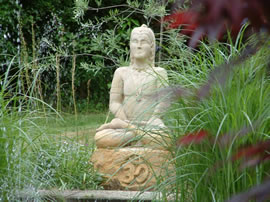The Science of Shat Karmas – Swami Indrananda
(Six Actions to purify the body)
There is a general trend in the West as well as in the East that we hesitate (or I should say) dislike to learn/understand or undertake these most beneficial practices which have been passed on to us through the experiences of the Yoga Masters of yore as well as of our time.
In reality we, in our time, are more concerned with our outward appearance and showbiz than to see and look into the state of function of our internal organs and the cause of deterioration. Our physical structure, according to the scriptures, works as shield for the soul and stays there as long as it is in good condition. If so, have the scriptures pointed out the life span of the human life? Yes, just like we determine the lives of our pets and all other species on this earth, a human being is supposed, according to the following verse from Yajur Veda (32,24), normally recited every day in the morning and evening (at our Satsangs, too) to live for a hundred years:
Pashyema Sharadah Shatam, Jeevama Ssharadah Shatam,
Shrivuyaama Sharadah Shatam, Prabravaama Sharadah Shatam,
Adeenaah Syaama Sharadah Shatam, Bhuyashcha Sharadah Shataat”
Is it, then, possible for us to live a full span of our life as described above? Yes, if we follow seriously, honestly and regularly with full determination to overcome our weaknesses as described in authentic scriptures or taught by someone who has mastered this Vidya (science).
Does it mean that there were no illnesses/diseases in olden days? No, there have always been natural as well as unnatural deaths all the time but we are concerned, here, with the illnesses/diseases that can be avoided to restore our pristine health, strength and will power to continue our quest to reach the Divine abode.
A child cannot walk until he learns to sit, crawl, stand and take one by one step. We know well that it is not possible for any child except for a miraculous baby. The ‘Nature’ is formed of gross, subtle, and subtlest elements. How, on earth, can we ignore the physical aspect of our body and jump to its subtle/subtlest part to know our self? We must hark to the guidance of the experienced Masters of yore as described in the relevant Yoga scriptures.
Gheranda Samhita and Hatha Yoga Pradipika are considered to be authentic Texts (unless a translator tries to attract the readers to his/her views) on the philosophy and practice of Hatha Yoga. That was one of the reasons for Hans-ulrich Rieker to stay with his Guru in India while translating the ‘Pradipika’. Both these books claim that Hatha Yoga leads to Raja Yoga which teaches us how to control the psyche and emotions and rise above the mind.
Cleanliness is next to Godliness. Just as we thoroughly clean the utensils for the second or third cooking, wash our clothes regularly to wear them for the next time. Similarly, it is our responsibility to keep our body cleansed to avoid becoming prey to any illness/disease in order to continue our journey smoothly on the path of Yoga.
Even Patanjali Maharishi, considered to be the father of Yoga and composer of Ayurveda and Sanskrit Grammar, mentions in ‘Niyama’ (Observances by aspirants), ‘Shauch’ (Purification) as a first step to follow the path of Yoga (Ch.II, 32). Sri Swami Vivekananda Ji, explaining this aphorism, says that external purification is keeping the body pure; a dirty man will never be a Yogi. (Raja Yoga, p. 206).
Ayurveda is akin to Yoga; it explains about the knowledge of ‘life’, and how to prolong it; it lays down certain rules about dietetics and physic. Also, it is said that Patanjali Rishi had not only systemised Yoga through Yoga Sutras, but was the greatest Grammarian of his time and composed Texts on Ayurveda. and Sanskrit Grammar.
As everything changes with the lapse of time, our living habits change along with it; unfortunately for the worse and not for good. It was at that time when HATHA yogis in about 12century, passed on the science of ‘Shat Karmas’ to keep the body clean and strong in order to adhere to the path of higher Yoga. Therefore, it is imperative upon every aspirant of Yoga to master the Shat Karmas, six practices of cleanliness, as described in the relevant Texts, and follow the rules concerning our daily routine and habits.
Every practice from Neti (nostrils cleaning) to Nauli (control of the rectus abdominus muscles) is hard to follow/master but where there is a will there is a way. Experience has shown that when an aspirant has mastered them, s/he feels differently, thinks differently and leads the life differently.
Most of us (from Masters/teachers/students alike) suffer from minor illnesses such as cold, fever, headache, aches and pains, stresses and depressions but try to ignore or suppress them through unnatural treatments/ means. The result is that it keeps prospering inside the body through the help of undesirable gasses and imbalance of humours (Vat, Pitta and Kapha – according to Ayurveda) until it prevails everywhere and finally takes hold of the entire body. It is, then, a final blow and too late to start any treatment available to us.
We must remember that every illness/disease takes its roots very slowly until this body is saturated with undesirable gasses, and becomes incurable and a hindrance to live the full span of life. If we wish to follow the path of Yoga to reach its goal we must remain on our guard all the time to keep this ‘Sharir’ (body) thoroughly cleansed regularly as described in Hatha Yoga or Ayurveda. DON’T WAIT – START YOUR ACTION IMMEDIATELY.
TO ACHIEVE OUR GOAL.Om Shanti Shanti Shanti Om
